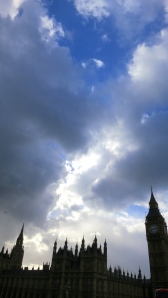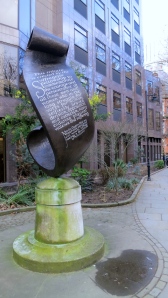Yesterday I promised Richard a copy of the photograph of him shovelling shingle. I printed it A3+ size today, and am very pleased with it.
Jackie drove me to Southampton Parkway after lunch. I then took my usual route to Carol’s, involving a train to Waterloo and a walk across Westminster Bridge and down Victoria Street.
On the south side of the River Thames The London Dungeon drew its usual crowds. At the top of the entrance steps stands a barrow loaded with human corpses wrapped in sacking.  The occasional hand escaping from its primitive body-bag no longer twitched, unlike those of a visitor anxious to venture inside to feast her eyes on further gruesome spectacles. Perhaps the dead bodies had once entered with rather more trepidation.
The occasional hand escaping from its primitive body-bag no longer twitched, unlike those of a visitor anxious to venture inside to feast her eyes on further gruesome spectacles. Perhaps the dead bodies had once entered with rather more trepidation.
 Rainclouds gathered above Westminster Bridge and the silhouettes of some of the most photographed buildings in the world.
Rainclouds gathered above Westminster Bridge and the silhouettes of some of the most photographed buildings in the world.

 Flocks of pigeons lazing and foraging in a now much reduced little green at the Victoria Street end of Broadway, suddenly disturbed, periodically took flight and arranged themselves on safe perches in the plane trees above.
Flocks of pigeons lazing and foraging in a now much reduced little green at the Victoria Street end of Broadway, suddenly disturbed, periodically took flight and arranged themselves on safe perches in the plane trees above.
The green is Christchurch Gardens which has a history probably unknown to the millions passing by. There is no surviving evidence of either of the two chapels or the Church of Christ Church Broadway which have stood on the site at different times.
A chapel dedicated to St Mary Magdalene had occupied the area then known as Tothill Fields as early as the 13th century. By 1598, according to John Stowe, the building was ‘now wholly ruined’.
 A new churchyard of St Margaret’s, known as The New Chapel was consecrated by the Dean of Westminster in December 1626. During the Commonwealth period it was used as a stable by Parliamentary soldiers and as avail for Scots prisoners captured at the Battle of Worcester. Twelve hundred of these prisoners were said to have died and been interred in the fields.
A new churchyard of St Margaret’s, known as The New Chapel was consecrated by the Dean of Westminster in December 1626. During the Commonwealth period it was used as a stable by Parliamentary soldiers and as avail for Scots prisoners captured at the Battle of Worcester. Twelve hundred of these prisoners were said to have died and been interred in the fields.
In the 19th century the New Chapel was demolished and replaced by Christ Church Broadway. Less than 100 years later, this in turn was destroyed by German incendiary bombs in the early morning of 17th April 1941.
Sadly, as in many London public spaces, this one now bears a sign telling you what you can’t do in them.
 On one corner is situated a tribute to those who suffered in the suffragette movement which fought for votes for women in the early twentieth century. The body of their leader, Emmeline Pankhurst, is buried in Brompton Cemetery. Her gravestone in the form of a celtic cross features in ‘The Magnificent Seven’.
On one corner is situated a tribute to those who suffered in the suffragette movement which fought for votes for women in the early twentieth century. The body of their leader, Emmeline Pankhurst, is buried in Brompton Cemetery. Her gravestone in the form of a celtic cross features in ‘The Magnificent Seven’.
After visiting Carol, I returned to Southampton where Jackie was waiting to drive me home.
 Noticing my reflection in the window of the 507 bus to Waterloo as it passed St. Thomas’s Hospital, I was reminded of the keen observation skills of Jackie and Judith Munns in August 2012. I had posted a photograph of the Sigoules boulangerie on an afternoon following a morning visit to the hairdressers there. ‘Good haircut’, Jackie had texted from England. How, I wondered, had she known? The answer was that I was unwittingly reflected in the baker’s window.
Noticing my reflection in the window of the 507 bus to Waterloo as it passed St. Thomas’s Hospital, I was reminded of the keen observation skills of Jackie and Judith Munns in August 2012. I had posted a photograph of the Sigoules boulangerie on an afternoon following a morning visit to the hairdressers there. ‘Good haircut’, Jackie had texted from England. How, I wondered, had she known? The answer was that I was unwittingly reflected in the baker’s window.
 On the return train journey, I amused my fellow travellers, most of whom were engrossed in laptops, by commenting that ‘when I commuted everyone read books’. ‘Times have changed’, was a young woman’s smiling reply.
On the return train journey, I amused my fellow travellers, most of whom were engrossed in laptops, by commenting that ‘when I commuted everyone read books’. ‘Times have changed’, was a young woman’s smiling reply.
When we arrived home we dined on superb sausage casserole (recipe); green beans; orange carrots; red cabbage with chillies; and yellow swede, potato, and onion mash.
Such colourful descriptions of the meal!
I could have said brown sausages but that would have been a bit unseemly x
Good Grief!!!!!